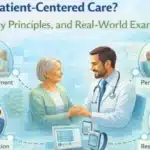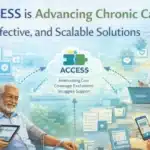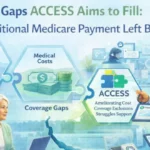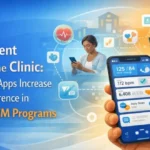All About FQHC or RHC Remote Patient Monitoring Changes in 2025

The remote patient monitoring (RPM) systems that Federally Qualified Health Centers (FQHCs) and Rural Health Clinics (RHCs) utilize have transformed in response to new CMS regulations. Changes to the RPM guidelines enable effortless billing for the provision of services, enhance care coordination, and improve patient outcomes for populations residing in rural and underserved areas.
With remote healthcare codes and billing conventions evolving with the surge of remote care and monitoring services, the latest Physician Fee Schedule (PFS) by the Centers for Medicare and Medicaid Services (CMS) has introduced pivotal changes in billing conventions for Federally Qualified Health Centers (FQHCs) and Rural Health Clinics (RHCs).
Being the foundation of accessible and equitable healthcare, both FQHCs and RHCs act as lifelines for individuals who don’t have easy access to healthcare programs. These centers are playing a critical role in boosting the ongoing efforts to enhance access to healthcare for everyone. All because of their dedication to affordability, cultural competence, preventive care, and community collaboration, they are stepping forward to create a society that is both healthier and inclusive.
Wondering how are the latest 2025 CMS updates transforming RPM reimbursement for FQHCs & RHCs? With the introduction of specific CPT codes and the elimination of G0511, providers must adapt to ensure compliance and maximize revenue. The Medicare Physician Fee Schedule (PFS) final rules for 2025 have made it even more worthwhile for FQHCs and RHCs to launch RPM and remote care management programs.
Table of Contents
ToggleRecent Updates on Remote Monitoring Services for Federally Qualified Health Centers (FQHCs)
Federally Qualified Health Centers (FQHCs) have experienced significant changes in Remote Patient Monitoring (RPM) services with an aim to enhance care delivery and reimbursement processes.
- Decommissioning of G0511 Code For Care Management: CMS announced that it is decommissioning the G0511 code, allowing FQHCs to use existing CPT codes for billing both RPM and Chronic Care Management (CCM) services. In 2025, FQHCs and RHCs must code and bill these care coordination services using their existing Current Procedural Terminology (CPT) codes.
To help FQHCs and RHCs with an easy transition, the CMS has granted a six-month transition period till the end of June 2025, during which they can still bill G0511.
- Transition from G0511 to Specific CPT Codes: In 2025, CMS finalized the transition from the previously introduced, all-inclusive HCPCS code G0511 to individual Current Procedural Terminology (CPT) codes for RPM services. This shift allows FQHCs to bill more accurately for different remote patient monitoring services provided. The newly applicable CPT codes for RPM include:
-
- 99453: Initial setup and patient education on the use of RPM devices.
- 99454: Supply of RPM devices and data transmission every 30 days.
- 99457: Remote monitoring and treatment management services, including at least 20 minutes of clinical staff time.
- 99458: Used for each additional 20 minutes of treatment management services, extending to CPT code 99457.
- Expanded Coverage For Care Management Services: In addition to Remote Patient Monitoring, Chronic Care Management, and Remote Therapeutic Monitoring (RTM) services, CMS has now allowed FQHCs and RHCs for providing care services for:
-
- PCM (Principal Care Management): Manages overall patient health through primary care, preventive services, and chronic disease management.
- BHI (Behavioral Health Integration): Combines behavioral health services with primary care for holistic mental and physical health management.
- CHI (Community Health Integration): Addresses social determinants of health through community-based health programs to improve well-being.
- PIN (Principal Illness Navigation): PIN services are navigation services provided by auxiliary personnel or peer support providers for patients with a serious and high-risk condition.
- APCM (Advanced Primary Care Management): Offers enhanced, patient-centered care using technology and data for proactive health management.
- Improved Billing Opportunities For Remote Patient Monitoring: The 2025 billing rule improved the billing opportunities for FQHCs and RHCs by expanding the coverage of care management services. Allowing FQHCs and RHCs to use existing care management CPT codes for billing helps focus on providing patients with the right treatments and sufficient consultation time. This change not only boosts precision in the delivery of care management services but also improves reimbursement opportunities.
Remote Patient Monitoring Improves Accessibility & Outcomes for FQHCs and RHCs
While remote patient monitoring benefits patients across the country, providing access to these services through FQHCs and RHCs is a significant step towards improving patient care and outcomes. Since their patients have a higher frequency of chronic diseases, are underserved and economically disadvantaged, RPM significantly improves accessibility and outcomes for them.
Because of their integrated care approach and emphasis on social determinants of health, FQHCs and RHCs are especially well adapted to care management.
Launching an RPM Program for FQHC & RHC is Easy & Straightforward
The primary Medicare requirements that FQHCs and RHCs must follow when launching remote patient monitoring services are quite straightforward. An FQHC or RHC would need to select the condition(s) they want to manage remotely and then launch the RPM program to provide the service to their patients.
After the patients have consented and are enrolled, they must be given an electronically connected RPM device to collect their physiological data, such as heart rate, pulse rate, blood pressure, oxygen levels, glucose levels, weight, or more. FQHCs and RHCs may even mail devices to their patients. In needed, they can even request the patients to pick up their RPM devices from the facility itself.
Once set up, the device collects health data from the patient and electronically transmits it to the FQHC or RHC. The FQHC or RHC staff then analyzes this data and provides the right health advice and interventions based on the findings.
With these CMS changes, FQHCs and RHCs must adjust their approach to RPM implementation. Here are some steps to ensure compliance and maximize reimbursement opportunities:
- Assess Patient Population: Determine which patients would benefit the most from RPM, such as those with hypertension or chronic heart disease.
- Select the Right RPM Devices: Invest in easy to connect and ready to use cellular-enabled medical devices to ensure reliable data transmission.
- Staff Training: Educate clinical and administrative staff about RPM procedures, device configuration, reimbursement and billing needs.
- Update Billing Processes: Include the new CPT codes in billing procedures to guarantee compliance with CMS rules.
By following these steps, FQHCs and RHCs can improve patient outcomes, operational efficiency, and financial sustainability through efficient RPM program implementation.
HealthArc Simplifies Care Management For FQHCs & RHCs
The 2025 CMS update on billing code provides FQHCs with chances to improve RPM services and billing methods. By implementing these modifications, FQHCs can improve care coordination, maximize reimbursement, and provide quality care to underserved communities dealing with chronic conditions.
HealthArc is your trusted partner for improving patient outcomes and engagement with a comprehensive digital health platform that can be simply integrated and launched in any workflow environment.
Our AI-powered platform provides clinical pathways for each disease type, which can be configured with provider input to focus on at-risk or non-compliant patients who require regular consultation with their healthcare providers. In addition, billing documentation is available for Remote Patient Monitoring (RPM), Chronic Care Management (CCM), Principal Care Management (PCM), Remote Therapeutic Monitoring (RTM), and Transitional Care Management (TCM) services for accurate reimbursements.
Please request a free demo to learn about FQHCs billing codes. Also, feel free to talk to our team at (201) 885 5571 for any queries about the recent billing code changes for FQHCs and RHCs.
Key Takeaways
- Updated Reimbursement: Broader billing opportunities.
- Regulatory Clarity: Easier compliance for facilities.
- Access Expansion: More patients can benefit from RPM.
- Operational Efficiency: Improved care delivery processes.
Frequently Asked Questions (FAQs)
In 2025, RPM reimbursement policies for FQHCs and RHCs were modified by CMS alongside the implementation of new reimbursement policies for remote patient monitoring (RPM). FQHCs and RHCs now have more defined Chronic and Acute Care RPM billing thresholds, new CPT codes, and less cumbersome documentation requirements.
RPM reimbursements for FQHCs and RHCs are now more favorable due to the new CMS rules, which align reimbursement policies for RPM billable services for FQHC and RHC providers to match other provider groups. Changes focusing on general care management code (G0511) reimbursement and bundling clarifications, furthers the equitable reimbursement structure for these facilities.
As for the remote patient monitoring (RPM) services for FQHCs and RHCs, other compliance areas defined by CMS must be adhered to, such as:
- Utilization of the defined CPT codes (99453, 99454, G0511).
- Maintaining data privacy regulations (HIPAA).
- Accurate documentation of time, data results, patient interactions, consents, and approvals, as well as the data analysis relevant to defined roles.
- Complying with patient and device user eligibility requirements.
These facilities can bill for device setup and education (99453), monthly data transmission and monitoring (99454), and clinically relevant review and decision-making for data. Under newer policies, these services can also be billed using G0511.
Most Recent Blogs
Categories
Related Blog
- November 26, 2025 | Read Time: 14 mins
Return on Investment (ROI) of Remote Patient Monitoring (RPM): A Complete Guide for ACOs and Healthcare Organizations
The U.S. healthcare system continues its transition from fee-for-service models to value-based...
Learn More- November 24, 2025 | Read Time: 15 mins
Common RPM Pricing Models for Providers: A Profitability-Focused Guide
Remote Patient Monitoring (RPM) has rapidly emerged as one of the leading...
Learn More- October 23, 2025 | Read Time: 12 mins
How RPM Devices Improve Hypertension and Diabetes Outcomes in Medicare Populations
Remote patient monitoring (RPM) is transforming chronic care for Medicare beneficiaries. CMS...
Learn More


